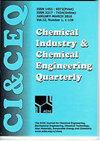油田污水余热利用的节能技术
IF 0.8
4区 工程技术
Q4 CHEMISTRY, APPLIED
Chemical Industry & Chemical Engineering Quarterly
Pub Date : 2022-01-01
DOI:10.2298/ciceq211201019s
引用次数: 0
摘要
目前的工作旨在改造现有的埃及油田装置,以提高脱盐性能并降低原油运输泵的功率。在这项工作中,废水中的废热代表一个值,用于加热注入脱盐剂的微咸水,以及在运输前加热原油。采用ASPEN HYSYS 11版仿真软件。考虑的油田装置的改造是基于两个新的热交换器的实施,以回收废水中的废热。结果表明:利用余热将脱盐器中的微咸水从30℃加热到71.11℃。C会提高脱盐器的工作温度,从而提高沉淀和分离速度。另一方面,在装船前使用余热加热原油从37.78到71.11?C使油粘度从1.536降至0.9735 cSt。降低原油的粘度将降低运输泵的压降,因此泵送油所需的功率将降低。本文提出的改造设计可作为现有电厂和设计阶段电厂升级改造的指导。本文章由计算机程序翻译,如有差异,请以英文原文为准。
Energy saving in oilfields by using waste heat in the disposed water
The present work aims to retrofit an existing Egyptian oilfield plant to improve desalter performance and reduce the power of crude oil shipping pumps. In this work waste heat in disposed water that represents a value is used in heating brackish water injected over desalter and in heating crude oil before shipping. ASPEN HYSYS version 11 simulation software was used. The retrofit of the considered oilfield plant is based on the implementation of two new heat exchangers to recover waste heat in the disposed water. The results showed that the use of waste heat in heating the brackish water in the desalter from 30 to 71.11?C will increase the operating temperature of the desalter and thus increase the sedimentation and separation rate. On the other hand, using waste heat in heating the crude oil before shipping from 37.78 to 71.11?C reduces the oil viscosity from 1.536 to 0.9735 cSt. Reducing the viscosity of the crude oil will reduce the pressure drop of the shipping pumps, and therefore the power required to pump the oil will be reduced. The presented retrofit design can be used as a guide in upgrading existing plants and plants under the design phase.
求助全文
通过发布文献求助,成功后即可免费获取论文全文。
去求助
来源期刊

Chemical Industry & Chemical Engineering Quarterly
CHEMISTRY, APPLIED-ENGINEERING, CHEMICAL
CiteScore
2.10
自引率
0.00%
发文量
24
审稿时长
3.3 months
期刊介绍:
The Journal invites contributions to the following two main areas:
• Applied Chemistry dealing with the application of basic chemical sciences to industry
• Chemical Engineering dealing with the chemical and biochemical conversion of raw materials into different products as well as the design and operation of plants and equipment.
The Journal welcomes contributions focused on:
Chemical and Biochemical Engineering [...]
Process Systems Engineering[...]
Environmental Chemical and Process Engineering[...]
Materials Synthesis and Processing[...]
Food and Bioproducts Processing[...]
Process Technology[...]
 求助内容:
求助内容: 应助结果提醒方式:
应助结果提醒方式:


